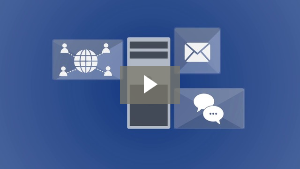Just a couple decades ago, business owners depended on single countermeasures and stratagems to fend off external attacks. But by the looks of it, hackers seem to be attacking businesses from every conceivable angle. Case in point, phishing, ransomware, zero-day hacks, and targeted attacks are just a few of the devastating attacks we’ve seen evolve into new heights this year.
There is no such thing as a miracle cure in network security. You cannot simply buy one security tool to magically solve all your cybersecurity problems. Guaranteeing network security is about preventing several attacks with multiple layers of defenses to ensure that the bad guys can’t get past the various barriers you put in their way.
Physical security
In the world of information security, it can be easy to completely neglect the physical security of servers, desktops, and USB drives. Unlike dramatic cyberattacks, which need a certain amount of expertise, breaches of physical security can be carried out by anyone. This means any stranger can walk in and steal company data if you don’t have appropriate physical security in place. Surprisingly, the solution can be as easy as locking a few cabinets, keeping track of backup media, and installing surveillance systems to deter attackers from stealing valuable business data.
Firewalls and network inspection
Much like the walls and gateways you need to block intruders from entering your office building, firewalls and intrusion prevention systems (IPS) act like network-level perimeter security. Firewalls keep a substantial amount of known attacks at bay by preventing unauthorized access to or from a network. This prevents script kiddies, who copy and paste publicly available attack tools made by other hackers, from infiltrating your corporate network.
Alternatively, IPS can detect and block unknown attacks by recognizing patterns of traffic or requested access that may foreshadow an attack. Whether it’s a denial of service (DoS) attack, polymorphic malware, phishing attempt, or rootkit, IPS is designed to filter out these attempted hacks. While firewalls and IPSs are powerful cybersecurity tools, make sure you still have sufficient resources for...
Endpoint protection
Desktop PCs and laptops are the most critical hardware that need protection. Antivirus, for example, is backed by security intelligence to identify and quarantine malware infections within your hard drive. But endpoint protection doesn’t stop once you’ve implemented antivirus solutions.
Application whitelisting, whereby you lock down what applications are and aren’t allowed to run on a workstation, can prevent suspicious software from running in the first place. Anti-spam tools can reduce the chances you’ll encounter phishing attempts. Even something as simple as updating operating systems and applications with the latest security patches can limit the vulnerabilities within your endpoints.
Staff training
In the end, no amount of endpoint protection software or network inspection tools can save your company if employees are repeatedly stumbling into malware-ridden sites, setting weak passwords, or connecting to unsecured wifi hotspots. Sure, URL filtering can prevent staff from accessing harmful websites, but training staff in safe web practices can go a long way.
If there’s one takeaway here, it’s that overconfidence in one security solution is a vulnerable shield. Whether you like it or not, hackers will continue to explore multiple attack vectors to steal your company’s assets. So for the sake of your employees and your business, a layered defense is the only way to go.
Even if you think all is well, it’s crucial to speak to a managed services provider to assess the security of your systems. Enhancing your defenses can be a long and convoluted road. Luckily, IntelligISTM can show you the way. Get in touch with us at www.intelligis.com to find out how you can protect your business.


